A Polyphenolic Extract from Olive Mill Wastewaters Encapsulated in Whey Protein and Maltodextrin Exerts Antioxidant Activity in Endothelial Cells
Abstract
:1. Introduction
2. Materials and Methods
2.1. Preparation of Encapsulation Powders
2.2. Free-Radical Scavenging Activity
2.3. Peroxyl-Radical-Induced Plasmid DNA Strand Cleavage
2.4. Reducing Power
2.5. Evaluation of Relative Antioxidant Capacity Index (RACI)
2.6. Cell Culture Conditions
2.7. XTT Cell Viability Assay
2.8. Treatment of EA.hy926 Cells with the Powders
2.9. Assessment of GSH and ROS Levels in EA.hy926 Cells by Flow Cytometry
2.10. Statistical Analysis
3. Results
3.1. Free-Radical Scavenging Activity of the Powders
3.2. Protection from ROO•-Induced Plasmid DNA Strand Cleavage
3.3. Reducing Capacity of the Extracts
3.4. Determination of Extracts’ Non-Cytotoxic Concentrations in EA.hy926 Cells
3.5. Effects of Powders on GSH Levels in EA.hy926 Cells
3.6. Effects of Powders on ROS Levels in EA.hy926 Cells
4. Discussion
5. Conclusions
Author Contributions
Funding
Conflicts of Interest
References
- Frankel, E.; Bakhouche, A.; Lozano-Sánchez, J.; Segura-Carretero, A.; Fernández-Gutiérrez, A. Literature review on production process to obtain extra virgin olive oil enriched in bioactive compounds. Potential use of byproducts as alternative sources of polyphenols. J. Agric. Food Chem. 2013, 61, 5179–5188. [Google Scholar] [CrossRef] [PubMed]
- Stagos, D.; Amoutzias, G.D.; Matakos, A.; Spyrou, A.; Tsatsakis, A.M.; Kouretas, D. Chemoprevention of liver cancer by plant polyphenols. Food Chem. Toxicol. 2012, 50, 2155–2170. [Google Scholar] [CrossRef] [PubMed]
- Gerasopoulos, K.; Stagos, D.; Kokkas, S.; Petrotos, K.; Kantas, D.; Goulas, P.; Kouretas, D. Feed supplemented with byproducts from olive oil mill wastewater processing increases antioxidant capacity in broiler chickens. Food Chem. Toxicol. 2015, 82, 42–49. [Google Scholar] [CrossRef] [PubMed]
- Gerasopoulos, K.; Stagos, D.; Petrotos, K.; Kokkas, S.; Kantas, D.; Goulas, P.; Kouretas, D. Feed supplemented with polyphenolic byproduct from olive mill wastewater processing improves the redox status in blood and tissues of piglets. Food Chem. Toxicol. 2015, 86, 319–327. [Google Scholar] [CrossRef] [PubMed]
- Makri, S.; Kafantaris, I.; Savva, S.; Ntanou, P.; Stagos, D.; Argyroulis, I.; Kotsampasi, B.; Christodoulou, V.; Gerasopoulos, K.; Petrotos, K.; et al. Novel Feed Including Olive Oil Mill Wastewater Bioactive Compounds Enhanced the Redox Status of Lambs. In Vivo 2018, 32, 291–302. [Google Scholar] [PubMed]
- Mohan, A.; Rajendran, S.R.C.K.; He, Q.S.; Bazinet, L.; Udenigwe, C.C. Encapsulation of food protein hydrolysates and peptides: A review. RSC Adv. 2015, 97, 79270–79278. [Google Scholar] [CrossRef]
- Fang, Z.; Bhandari, B. Encapsulation of polyphenols—A review. Trends Food Sci. Technol. 2010, 21, 510–523. [Google Scholar] [CrossRef]
- Jafari, S.M.; Assadpoor, E.; He, Y.; Bhandari, B. Encapsulation efficiency of food flavors and oils during spray drying. Dry Technol. 2008, 26, 816–835. [Google Scholar] [CrossRef]
- Kerasioti, E.; Stagos, D.; Georgatzi, V.; Bregou, E.; Priftis, A.; Kafantaris, I.; Kouretas, D. Antioxidant Effects of Sheep Whey Protein on Endothelial Cells. Oxid. Med. Cell Longev. 2016, 2016, e6585737. [Google Scholar] [CrossRef]
- Deanfield, J.E.; Halcox, J.P.; Rabelink, T.J. Endothelial function and dysfunction: Testing and clinical relevance. Circulation 2007, 115, 1285–1295. [Google Scholar] [CrossRef]
- Papadopoulou, A.; Petrotos, K.; Stagos, D.; Gerasopoulos, K.; Maimaris, A.; Makris, H.; Kafantaris, I.; Makri, S.; Kerasioti, E.; Halabalaki, M.; et al. Enhancement of Antioxidant Mechanisms and Reduction of Oxidative Stress in Chickens after the Administration of Drinking Water Enriched with Polyphenolic Powder from Olive Mill Waste Waters. Oxid. Med. Cell. Longev. 2017, 2017, 8273160. [Google Scholar] [CrossRef] [PubMed]
- Stagos, D.; Portesis, N.; Spanou, C.; Mossialos, D.; Aligiannis, N.; Chaita, E.; Panagoulis, C.; Reri, E.; Skaltsounis, L.; Tsatsakis, A.M.; et al. Correlation of total polyphenolic content with antioxidant and antibacterial activity of 24 extracts from Greek domestic Lamiaceae species. Food Chem. Toxicol. 2012, 50, 4115–4124. [Google Scholar] [CrossRef] [PubMed]
- Stagos, D.; Balabanos, D.; Savva, S.; Skaperda, Z.; Priftis, A.; Kerasioti, E.; Mikropoulou, E.V.; Vougogiannopoulou, K.; Mitakou, S.; Halabalaki, M.; et al. Extracts from the Mediterranean Food Plants Carthamus lanatus, Cichorium intybus, and Cichorium spinosum Enhanced GSH Levels and Increased Nrf2 Expression in Human Endothelial Cells. Oxid. Med. Cell. Longev. 2018, 2018, 6594101. [Google Scholar] [CrossRef] [PubMed]
- Sun, T.; Tanumihardjo, S.A. An integrated approach to evaluate food antioxidant capacity. J. Food Sci. 2007, 72, R159–R165. [Google Scholar] [CrossRef] [PubMed]
- Rinaldi, M.; Rana, G.; Introna, M. Olive-mill wastewater spreading in southern Italy: Effects on a durum wheat crop. Field Crops Res. 2003, 84, 319–326. [Google Scholar] [CrossRef]
- Caporaso, N.; Formisano, D.; Genovese, A. Use of phenolic compounds from olive mill wastewater as valuable ingredients for functional foods. Crit. Rev. Food Sci. Nutr. 2018, 58, 2829–2841. [Google Scholar] [CrossRef] [PubMed]
- Caporaso, N.; Genovese, A.; Burke, R.; Barry-Ryan, C.; Sacchi, R. Effect of olive mill wastewater phenolic extract, whey protein isolate and xanthan gum on the behaviour of olive O/W emulsions using response surface methodology. Food Hydrocoll. 2016, 61, 66–76. [Google Scholar] [CrossRef] [Green Version]
- Ahn, J.H.; Kim, Y.P.; Lee, Y.M.; Seo, E.M.; Lee, K.W.; Kim, H.S. Optimization of microencapsulation of seed oil by response surface methodology. Food Chem. 2008, 107, 98–105. [Google Scholar] [CrossRef]
- Carneiro, H.C.F.; Tonon, R.V.; Grosso, C.R.F.; Hubinger, M.D. Encapsulation efficiency and oxidative stability of flaxseed oil microencapsulated by spray drying using different combinations of wall materials. J. Food Eng. 2013, 115, 443–451. [Google Scholar] [CrossRef] [Green Version]
- Gharsallaoui, A.; Roudaut, G.; Chambin, O.; Voilley, A.; Saurel, R. Applications of spray drying in microencapsulation of food ingredients: An overview. Food Res. Int. 2007, 40, 1107–1121. [Google Scholar] [CrossRef]
- Bae, E.K.; Lee, S.J. Microencapsulation of avocado oil by spray drying using whey protein and maltodextrin. J. Microencapsul. 2008, 25, 549–560. [Google Scholar] [CrossRef] [PubMed]
- Caporaso, N.; Genovese, A.; Burke, R.; Barry-Ryan, C.; Sacchi, R. Physical and oxidative stability of functional olive oil-in-water emulsions formulated using olive mill wastewater biophenols and whey proteins. Food Funct. 2016, 7, 227–238. [Google Scholar] [CrossRef] [PubMed]
- Navarro, M.; Fiore, A.; Fogliano, V.; Morales, F.J. Carbonyl trapping and antiglycative activities of olive oil mill wastewater. Food Funct. 2015, 6, 574–583. [Google Scholar] [CrossRef] [PubMed]
- Troise, A.D.; Fiore, A.; Colantuono, A.; Kokkinidou, S.; Peterson, D.G.; Fogliano, V. Effect of olive mill wastewater phenol compounds on reactive carbonyl species and Maillard reaction end-products in ultrahigh-temperature-treated milk. J. Agric. Food Chem. 2014, 62, 10092–10100. [Google Scholar] [CrossRef] [PubMed]
- Sedej, I.; Milczarek, R.; Wang, S.C.; Sheng, R.; de Jesús Avena-Bustillos, R.; Dao, L.; Takeoka, G. Membrane-Filtered Olive Mill Wastewater: Quality Assessment of the Dried Phenolic-Rich Fraction. J. Food Sci. 2016, 81, E889–E896. [Google Scholar] [CrossRef] [PubMed]
- Nousis, L.; Doulias, P.T.; Aligiannis, N.; Bazios, D.; Agalias, A.; Galaris, D.; Mitakou, S. DNA protecting and genotoxic effects of olive oil related components in cells exposed to hydrogen peroxide. Free Radic. Res. 2005, 39, 787–795. [Google Scholar] [CrossRef] [PubMed]
- Obied, H.K.; Prenzler, P.D.; Konczak, I.; Rehman, A.U.; Robards, K. Chemistry and bioactivity of olive biophenols in some antioxidant and antiproliferative in vitro bioassays. Chem. Res. Toxicol. 2009, 22, 227–234. [Google Scholar] [CrossRef]
- Gould, R.L.; Pazdro, R. Impact of Supplementary Amino Acids, Micronutrients, and Overall Diet on Glutathione Homeostasis. Nutrients 2019, 11, 1056. [Google Scholar] [CrossRef]
- Masella, R.; Varì, R.; D’Archivio, M.; Di Benedetto, R.; Matarrese, P.; Malorni, W.; Scazzocchio, B.; Giovannini, C. Extra virgin olive oil biophenols inhibit cell-mediated oxidation of LDL by increasing the mRNA transcription of glutathione-related enzymes. J. Nutr. 2004, 134, 785–791. [Google Scholar] [CrossRef]
- Kumar, H.; Kim, I.S.; More, S.V.; Kim, B.W.; Choi, D.K. Natural product-derived pharmacological modulators of Nrf2/ARE pathway for chronic diseases. Nat. Prod. Rep. 2014, 31, 109–139. [Google Scholar] [CrossRef]
- Bayram, B.; Ozcelik, B.; Grimm, S. A diet rich in olive oil phenolics reduces oxidative stress in the heart of SAMP8 mice by induction of Nrf2-dependent gene expression. Rejuvenation Res. 2012, 15, 71–81. [Google Scholar] [CrossRef] [PubMed]
- Fki, I.; Sahnoun, Z.; Sayadi, S. Hypocholesterolemic effects of phenolic extracts and purified hydroxytyrosol recovered from olive mill wastewater in rats fed a cholesterol-rich diet. J. Agric. Food Chem. 2007, 55, 624–631. [Google Scholar] [CrossRef] [PubMed]
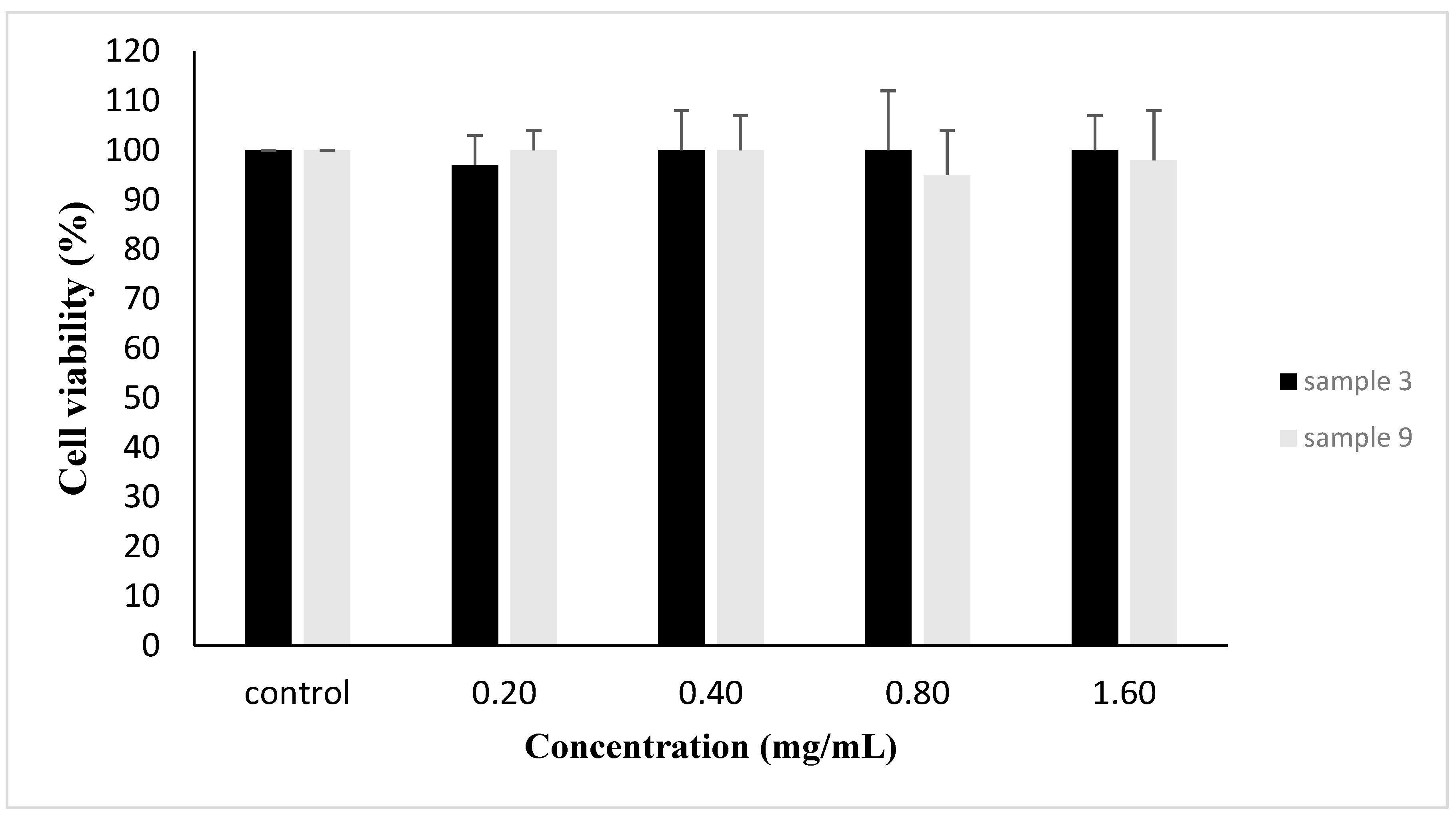
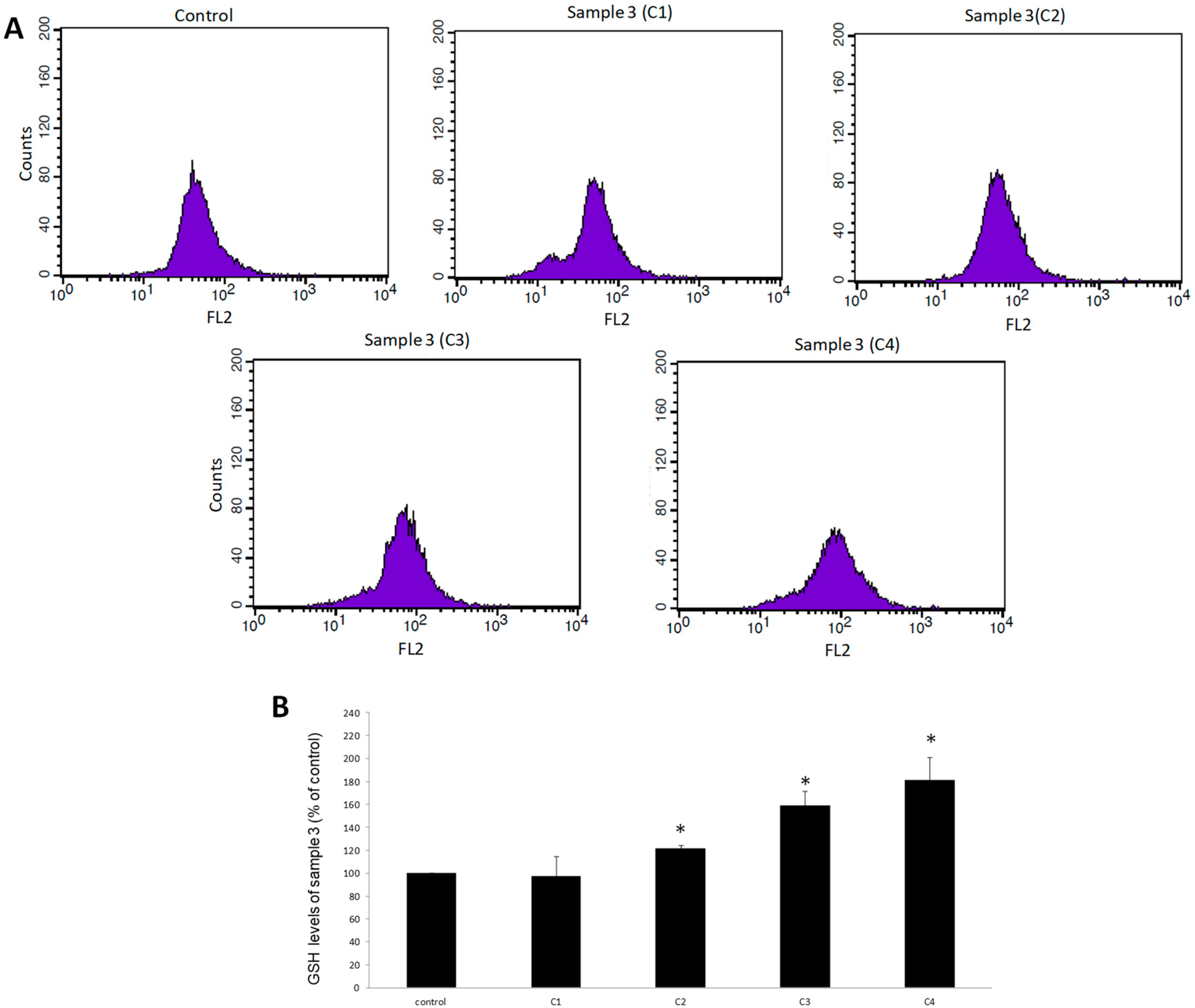
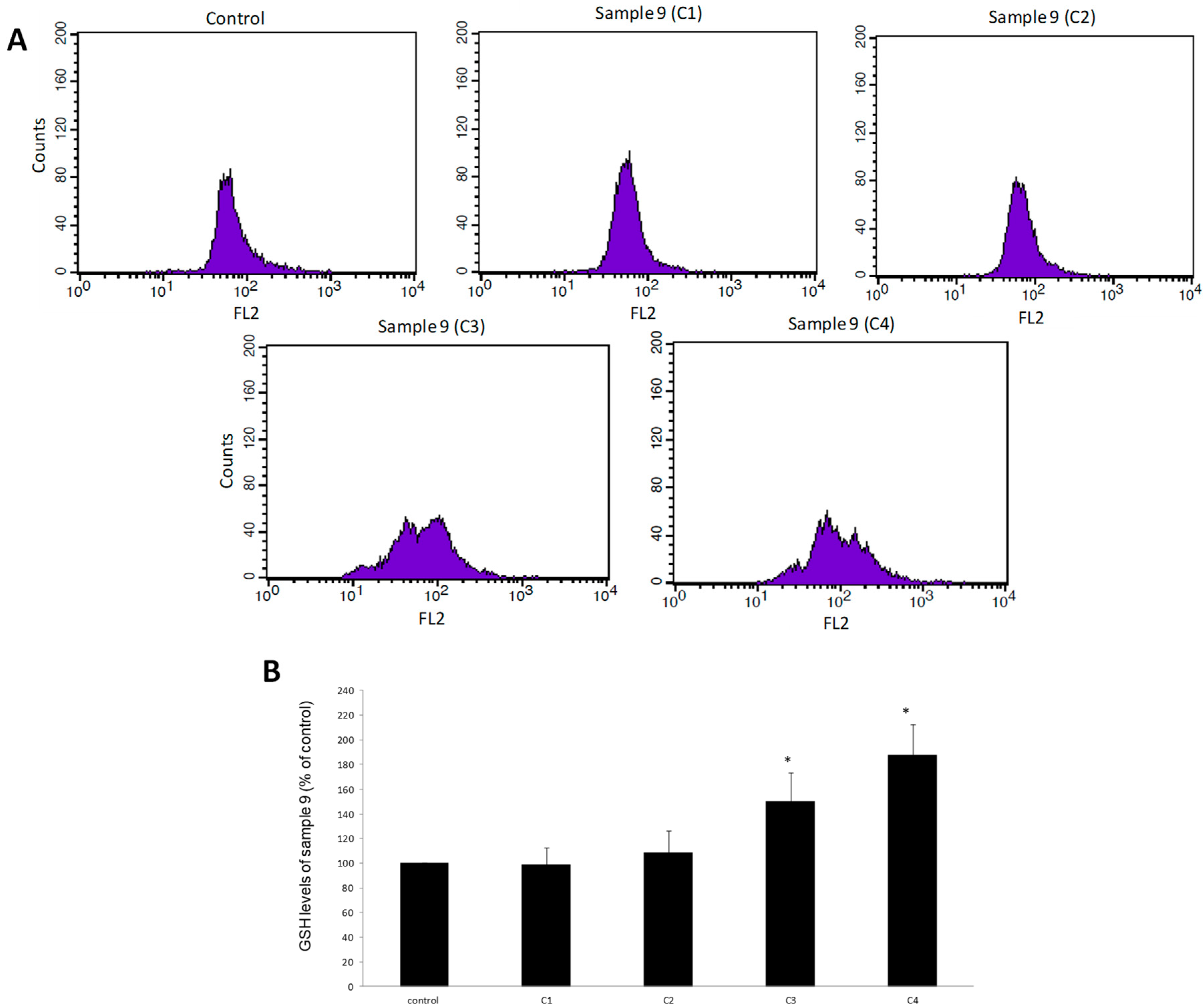
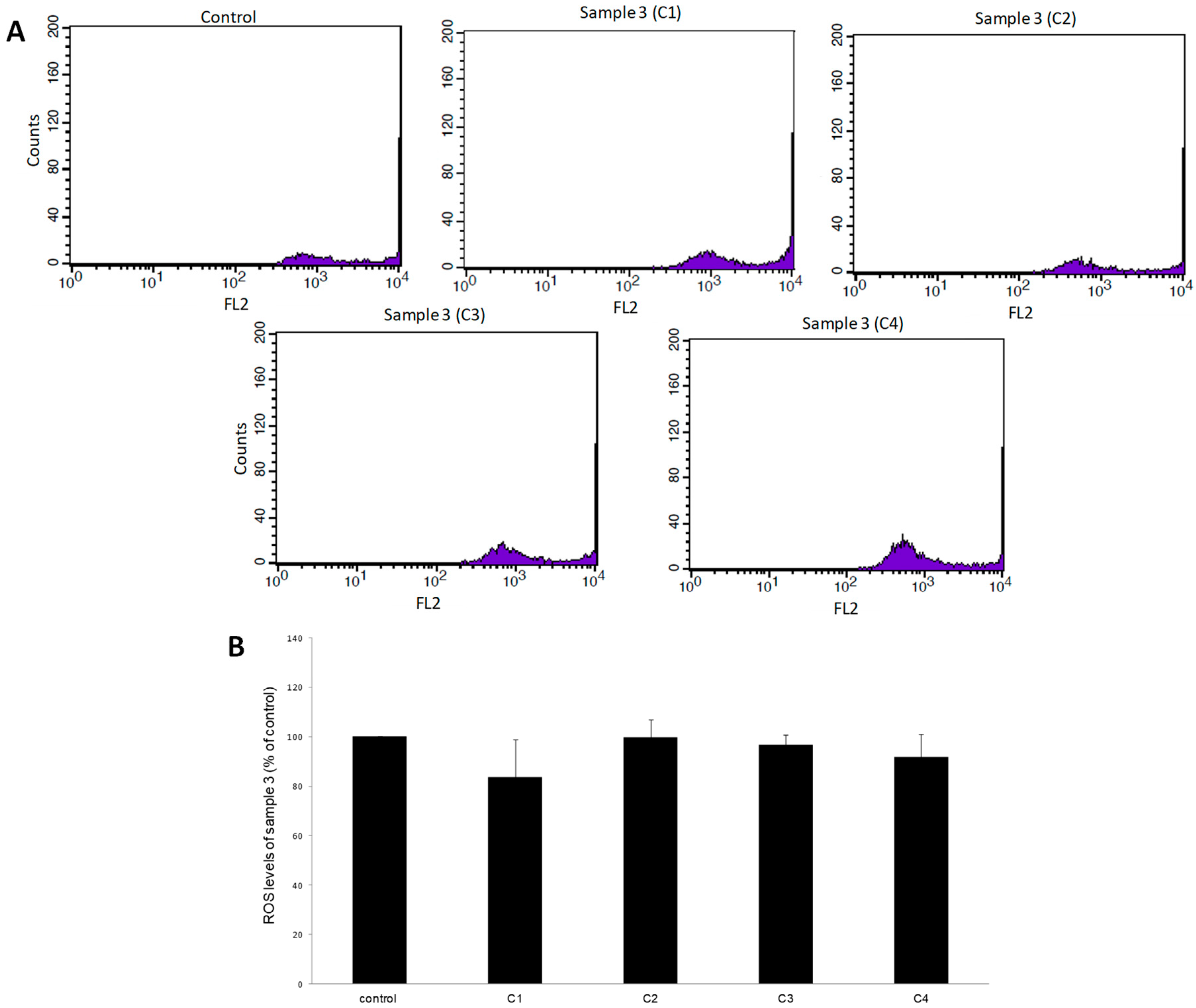
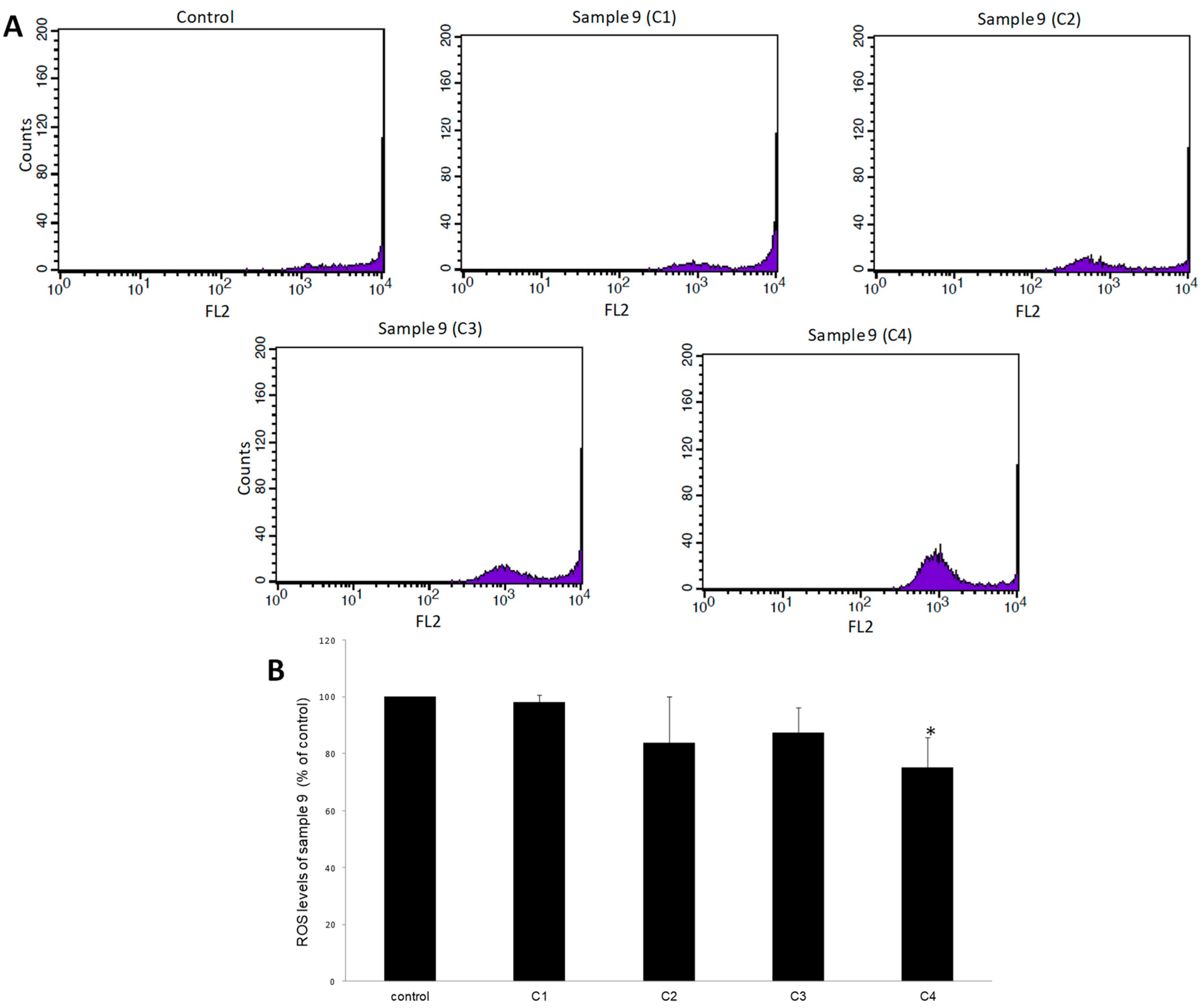
| Sample | Inlet Temperature (°C) | Outlet Temperature (°C) | Aspirator (%) | Pump (%) | MEDOLIVA (mL) | Tween80 (mL) | Whey Protein (gr) | Maltodextrin (gr) | Gelatin (gr) | H2O (mL) | Total Volume (mL) |
|---|---|---|---|---|---|---|---|---|---|---|---|
| 1 | 100 | 66 | 100 | 5 | 37.5 | 12.5 | 25 | - | - | 175 | 250 |
| 2 | 100 | 72 | 100 | 5 | 37.5 | 12.5 | 25 | - | - | 175 | 250 |
| 3 | 120 | 82 | 100 | 5 | 37.5 | 12.5 | 25 | - | - | 175 | 250 |
| 4 | 140 | 90 | 100 | 5 | 37.5 | 12.5 | 25 | - | - | 175 | 250 |
| 5 | 160 | 98 | 100 | 5 | 37.5 | 12.5 | 25 | - | - | 175 | 250 |
| 6 | 120 | 71 | 100 | 5 | 37.5 | - | 25 | - | 5 | 175 | 242.5 |
| 7 | 140 | 79 | 100 | 5 | 37.5 | - | 25 | - | 5 | 175 | 242.5 |
| 8 | 160 | 96 | 100 | 5 | 37.5 | - | 25 | - | 5 | 175 | 242.5 |
| 9 | 100 | 57 | 100 | 10 | 37.5 | 12.5 | - | 25 | - | 175 | 250 |
| 10 | 100 | 67 | 100 | 5 | 37.5 | 12.5 | - | 25 | - | 175 | 250 |
| 11 | 120 | 67 | 100 | 10 | 37.5 | 12.5 | - | 25 | - | 175 | 250 |
| 12 | 120 | 76 | 100 | 5 | 37.5 | 12.5 | - | 25 | - | 175 | 250 |
| 13 | 140 | 84 | 100 | 5 | 37.5 | 12.5 | - | 25 | - | 175 | 250 |
| 14 | 160 | 86 | 100 | 10 | 37.5 | 12.5 | - | 25 | - | 175 | 250 |
| 15 | 160 | 96 | 100 | 5 | 37.5 | 12.5 | - | 25 | - | 175 | 250 |
| 16 | 100 | 61 | 100 | 5 | 37.5 | - | - | 25 | 5 | 175 | 242.5 |
| 17 | 140 | 80 | 100 | 5 | 37.5 | - | - | 25 | 5 | 175 | 242.5 |
| Sample | ABTS a IC50 (μg/mL) | DPPH a IC50 (μg/mL) | ROO b IC50 (μg/mL) | Reducing power a 0.5 AU | RACI c |
|---|---|---|---|---|---|
| 1 | 428 ± 26 * | 295 ± 24 * | 800 ± 88 * | 660 ± 33 * | −0.76 |
| 2 | 355 ± 14 * | 340 ± 41 * | 1580 ± 63 * | 707 ± 28 * | −0.41 |
| 3 | 450 ± 36 * | 352 ± 46 * | 520 ± 41 * | 434 ± 30 * | −1.13 |
| 4 | 500 ± 45 * | 320 ± 10 * | 935 ± 84 * | 890 ± 18 * | −0.06 |
| 5 | 547 ± 16 * | 330 ± 26 * | 960 ± 57 * | 700 ± 21 * | −0.27 |
| 6 | 300 ± 22 * | 390 ± 16 * | 725 ± 67 * | ND | −1.03 |
| 7 | 510 ± 44 * | 385 ± 19 * | 1190 ± 111 * | ND | −0.13 |
| 8 | 710 ± 68 * | 409 ± 37 * | 2300 ± 227 * | ND | 1.19 |
| 9 | 290 ± 9 * | 295 ± 18 * | 590 ± 65 * | 689 ± 55 * | −1.11 |
| 10 | 390 ± 39 * | 526 ± 42 * | 2075 ± 103 * | 866 ± 30 * | 0.55 |
| 11 | 590 ± 51 * | 465 ± 47 * | 1600 ± 149 * | ND | 0.56 |
| 12 | 530 ± 46 * | 638 ± 51 * | 1250 ± 113 * | ND | 0.64 |
| 13 | 540 ± 38 * | 540 ± 16 * | 2250 ± 180 * | 747 ± 67 * | 0.78 |
| 14 | 520 ± 48 * | 650 ± 59 * | 1200 ± 113 * | ND | 0.61 |
| 15 | 430 ± 17 * | 660 ± 73 * | 1515 ± 136 * | 825 ± 8 * | 0.59 |
| 16 | 460 ± 42 * | 465 ± 65 * | 820 ± 77 * | ND | −0.29 |
| 17 | 590 ± 48 * | 510 ± 25 * | 1900 ± 86 * | ND | 0.86 |
| Vitamin C | 4 ± 0.3 * | 5 ± 0.4 * | 69 ± 5 * | 3 ± 0.4 * | - |
© 2019 by the authors. Licensee MDPI, Basel, Switzerland. This article is an open access article distributed under the terms and conditions of the Creative Commons Attribution (CC BY) license (http://creativecommons.org/licenses/by/4.0/).
Share and Cite
Kreatsouli, K.; Fousteri, Z.; Zampakas, K.; Kerasioti, E.; Veskoukis, A.S.; Mantas, C.; Gkoutsidis, P.; Ladas, D.; Petrotos, K.; Kouretas, D.; et al. A Polyphenolic Extract from Olive Mill Wastewaters Encapsulated in Whey Protein and Maltodextrin Exerts Antioxidant Activity in Endothelial Cells. Antioxidants 2019, 8, 280. https://doi.org/10.3390/antiox8080280
Kreatsouli K, Fousteri Z, Zampakas K, Kerasioti E, Veskoukis AS, Mantas C, Gkoutsidis P, Ladas D, Petrotos K, Kouretas D, et al. A Polyphenolic Extract from Olive Mill Wastewaters Encapsulated in Whey Protein and Maltodextrin Exerts Antioxidant Activity in Endothelial Cells. Antioxidants. 2019; 8(8):280. https://doi.org/10.3390/antiox8080280
Chicago/Turabian StyleKreatsouli, Konstantina, Zinovia Fousteri, Konstantinos Zampakas, Efthalia Kerasioti, Aristidis S. Veskoukis, Christos Mantas, Paschalis Gkoutsidis, Dimitrios Ladas, Konstantinos Petrotos, Demetrios Kouretas, and et al. 2019. "A Polyphenolic Extract from Olive Mill Wastewaters Encapsulated in Whey Protein and Maltodextrin Exerts Antioxidant Activity in Endothelial Cells" Antioxidants 8, no. 8: 280. https://doi.org/10.3390/antiox8080280
APA StyleKreatsouli, K., Fousteri, Z., Zampakas, K., Kerasioti, E., Veskoukis, A. S., Mantas, C., Gkoutsidis, P., Ladas, D., Petrotos, K., Kouretas, D., & Stagos, D. (2019). A Polyphenolic Extract from Olive Mill Wastewaters Encapsulated in Whey Protein and Maltodextrin Exerts Antioxidant Activity in Endothelial Cells. Antioxidants, 8(8), 280. https://doi.org/10.3390/antiox8080280








